|
|
|
Sort Order |
|
|
|
Items / Page
|
|
|
|
|
|
|
| Srl | Item |
| 1 |
ID:
182808
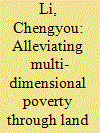

|
|
|
|
|
| Summary/Abstract |
This study constructs a Ramsey–Cass–Koopmans growth model of the agricultural sector, which includes land transfer characteristics, to investigate the theoretical basis of the land transfer impact on multi-dimensional poverty, under a steady equilibrium. Using 2010, 2012, and 2014 panel data from the Mutual Aid Fund for Poverty-Stricken Villages in China, we obtained results indicating the impact of land transfer on multi-dimensional poverty, based on the generalized propensity score method. The research results are as follows: (1) The intensity of rural households' land transfer in poverty-stricken villages remains low, at only 14.54%; however, it demonstrates an increasing trend. (2) When the intensity of land transfer is continuously enhanced, the multi-dimensional poverty of rural households in poverty-stricken villages decreases. (3) Rural households' land transfer in poverty-stricken villages can reduce multi-dimensional poverty by improving their savings behavior. “Precautionary savings motivation” is an important land transfer mechanism affecting rural households' multi-dimensional poverty in poverty-stricken villages.
|
|
|
|
|
|
|
|
|
|
|
|
|
|
|
|
| 2 |
ID:
182806
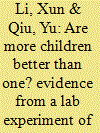

|
|
|
|
|
| Summary/Abstract |
This paper examines the impacts of siblings on people's social preference, risk attitude and time preference with a data set from a large-scale lab experiment. Employing the variation of fine rates under One-Child Policy for excess birth in different regions as instrument to address the endogeneity of whether having siblings, we find that sibling's role mainly focuses on shaping people's social preference that subjects with siblings demand less as responders in ultimatum game and behave more cooperatively in sequential prisoner's dilemma. This conclusion survives through several robustness checks. Our further result suggests that more sibling interactions and less parental expectations are two potential mechanisms through which siblings play a role in making people more prosocial. Our findings point to a positive externality along with Two-Child Policy which is widely neglected in both policy evaluation and relevant theory such as quantity-quality theory, and provide implications for the fertility policy such as the recent Three-Child Policy in China and beyond.
|
|
|
|
|
|
|
|
|
|
|
|
|
|
|
|
| 3 |
ID:
182788
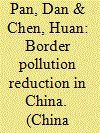

|
|
|
|
|
| Summary/Abstract |
This paper studies the effect of environmental regulations on border pollution reduction in developing countries' rural areas by taking livestock environmental regulations (LERs) in China as a quasi-natural experiment. Applying the generalized difference-in-difference-in-differences (DDD) method, we find that LERs are effective in reducing border pollution: the chemical oxygen demand (COD) and ammonia nitrogen (NH3−N) of the border counties are 21.78% and 39.51%, less than that of the interior counties. We document that the effectiveness of LERs in reducing border pollution can be attributed to the fact that LERs require local governments to make collective decisions in fighting livestock pollution. Further heterogeneity analysis finds that the reduction effect of LERs on border pollution is greater in the downstream border and underdeveloped areas. Our paper implies that the externality of border pollution can be internalized through collective decision-making between local governments.
|
|
|
|
|
|
|
|
|
|
|
|
|
|
|
|
| 4 |
ID:
182811
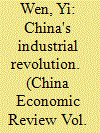

|
|
|
|
|
| Summary/Abstract |
In “The Industrial Structure of Production: An Outline of a Research Program,” Ronald Coase and Ning Wang (2001) made a plea for a new economic research program that can go beyond the Arrow-Debreu framework and explain China's miraculous rise. They point out that the greatest trouble with the Arrow-Debreu framework lies in its inability to explain production. In this article I will push this insight further to shed new light on why and how production, or mass production in particular, emerged and mushroomed in the 18th–19th century England, the 19th–20th century United States, and 20th-21st century China but not in other parts of the world with similar geo-developmental conditions such as the Netherlands, Mexico, or India. My central thesis is that production or firms emerge in response to market demand, yet the so-called “market” is itself a fundamental public good that must be created by a development state instead of the “invisible hand.” Therefore, the lack of industrialization in any nation seems on the surface due to the lack of mass supply, but is in fact due to the lack of a mass market, which in turn is due to the lack of powerful and strong-willed market creators.
|
|
|
|
|
|
|
|
|
|
|
|
|
|
|
|
| 5 |
ID:
182778


|
|
|
|
|
| Summary/Abstract |
In this paper, I examine the causal impact of college education on young adults' out-province migration in China using China Family Panel Studies 2010 wave data. I use the number of colleges at the province-year level to identify the effect of college attendance on young adults' later life location choice. 2SLS estimates suggest that attending college significantly increases the likelihood of residing in a different province later in life by 7.5 percentage points. A series of tests shows that the impact of college on migration is heterogenous to people's childhood location, gender, hukou origin, and occupation.
|
|
|
|
|
|
|
|
|
|
|
|
|
|
|
|
| 6 |
ID:
182789
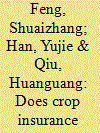

|
|
|
|
|
| Summary/Abstract |
We test how crop insurance participation affects the intensity of pesticide use in China using data on staple crop production from eight provinces. Our preferred specification instruments farmers' decisions of participation in insurance by village-level intensities of promotional activities and controls for province fixed effects. We find crop insurance participation significantly reduces pesticide use intensity. The reduction effect is greater for smaller plots, older farmers, and farmers who are more risk averse.
|
|
|
|
|
|
|
|
|
|
|
|
|
|
|
|
| 7 |
ID:
182782


|
|
|
|
|
| Summary/Abstract |
This study investigates the distortion of government disclosure on air pollution and further explores underlying political incentives that drive such distortion. We introduce a newly developed method, that is, bunching estimation based on notch points, to identify the distortion in the air pollution index disclosed by local governments. Results show that the magnitudes of distortion are significant and vary across cities. We present evidence that local politicians' promotion incentives substantially drive the distortion of environmental information. Importantly, we find that high-frequency disclosure requirements effectively discipline the behaviors of local governments because of increased manipulation costs. Overall, we contribute to the literature by identifying the distortion of government information disclosure, investigating the underlying causes, and examining the validity of new disclosure policies in shaping government behaviors.
|
|
|
|
|
|
|
|
|
|
|
|
|
|
|
|
| 8 |
ID:
182792
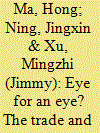

|
|
|
|
|
| Summary/Abstract |
We analyze the trade and price effects of China's retaliatory tariffs on imports from the United States in the period from January 2017 to May 2019. We apply the difference-in-differences approach to the up-to-date China Customs data on imports disaggregated by eight-digit HS product category and source country. We find large reductions in the value and quantity of imports from the US and an almost complete tariff pass-through onto import prices. These results remain robust to extensive changes in the specification and in data sample and to a variety of placebo tests using processing imports or exempted products that were originally included in the tariff lists but removed before implementation. We also find that the trade and price effects are heterogeneous across products, differing either in the end-use or in the ownership types of the importing firm. Similar to recent findings in the US (Amiti et al., 2019, Amiti et al., 2020), our estimates suggest limited terms-of-trade gain due to China's tariff hikes.
|
|
|
|
|
|
|
|
|
|
|
|
|
|
|
|
| 9 |
ID:
182781
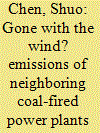

|
|
|
|
|
| Summary/Abstract |
Based on a nationwide representative county-level dataset from China, this article empirically examines the spillover effects of air pollution from neighboring coal-fired power plants on local mortality rates due to cardiovascular and respiratory diseases. We combine data on power plants' industrial output with information on wind direction and speed to proxy for air pollution, and find that air pollution from neighboring power plants indeed has significant negative effects on local public health. The resulting treatment costs are also enormous. Our findings shed light on the necessity of intergovernmental cooperation in environmental governance.
|
|
|
|
|
|
|
|
|
|
|
|
|
|
|
|
| 10 |
ID:
182798


|
|
|
|
|
| Summary/Abstract |
This paper studies the impact of household-level housing wealth changes on entrepreneurship in urban China. Exploiting the 2011–2015 China Household Finance Survey, we control for lagged proxies for wealth, city-by-year fixed effects, and other household attributes and directly estimate the magnitude of homeowner's response to housing capital gains net of home maintenance and upgrading expenditures. We also instrument for housing wealth changes with structural breaks in city housing price trend. We find that a 10,000 RMB increase in housing wealth increases the propensity of a household becoming a business owner by about 0.7 percentage points in IV estimation. In addition, we provide new evidence for underlying channels that housing capital gains alleviate household credit constraints, reduce risk aversion and increase awareness of financial information.
|
|
|
|
|
|
|
|
|
|
|
|
|
|
|
|
| 11 |
ID:
182794


|
|
|
|
|
| Summary/Abstract |
Conventional wisdom suggests that, if a large nation reduces tariffs, the Rest of the World (RoW) as a whole should immediately experience gains from trade. However, little simulation evidence has been provided to evaluate the welfare effects of China's tariff reduction upon its WTO accession on each of its trade partners. This paper addresses the above issue under both the perfectly competitive model and the monopolistic competition framework à la Eaton and Kortum (2002) and Melitz (2003). Armed by the method of Dekle, Eaton, and Kortum (2007, 2008) to quantify the individual countries' responses to the “China (trade liberalization) shock” at equilibrium, we could check the extent to which global welfare benefit from the import tariff reduction after China's entry into the WTO. The quantitative results show that, both China and the RoW benefit from Chinese participation into the WTO, with estimated welfare gains falling in a range of [1.4697%, 3.8743%] and [0.0743%, 0.1015%], respectively. That is to say, about 58.24% of total benefits extracted from China's accession into the WTO worldwide flow to countries other than China under perfect competition; while under monopolistic competition, the whole world enjoys a 0.1571% welfare increases if firms' entry is restricted, of which 42.64% are injected into the RoW, an equivalent amount of 23.3903 billion US dollars. Since allowing for firms' entry and exit would lead to adjustments in both aggregate price indices and government tariff revenues, welfare gains of the world significantly increase (0.2474%), but these adjustments would slightly distort the welfare changes for other countries in the sense that only 36.50%, which is equivalent to 32.1008 billion US dollars, overflow to the RoW. As a result, some countries gain more, while some less.
|
|
|
|
|
|
|
|
|
|
|
|
|
|
|
|
| 12 |
ID:
182809


|
|
|
|
|
| Summary/Abstract |
The loss of targeting efficiency due to information asymmetry is a longstanding problem in aid programs. China's Targeted Poverty Alleviation (TPA) program addresses this problem by assigning local government officials to individual impoverished households. These officials, referred to as poverty alleviation coordinators (PACs), are required to pay frequent home visits to the assigned households and to deploy policy resources for poverty reduction. The program is costly in terms of human resources because the officials also have regular duties in a variety of departments. We investigate the effects of the PAC system on poverty alleviation and explore the mechanisms of the effects. Based on the Chinese Poor Population Tracking Dataset and econometric analysis, we find that the households with a larger income increase are those whose PACs work in a department that has the type of resources needed by the household. This indicates that a good match between the resource and the need could enhance the effect of the TPA program. In addition, PACs at a higher position in the governance structure show a larger income increase in their assigned households, which is expected, because a higher position could have more resources to deploy. These findings shed light on role of institutional arrangements in alleviating information asymmetry in poverty reduction programs.
|
|
|
|
|
|
|
|
|
|
|
|
|
|
|
|
| 13 |
ID:
182805
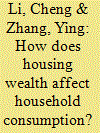

|
|
|
|
|
| Summary/Abstract |
Thanks to four-decade spectacular economic growth, China's households have been accumulating a stockpile of wealth. In such a context, further concerns have been raised about the relationship between wealth accumulation and improvement of economic well-being, mainly through consumption. The issue becomes even more important when considering the challenges facing China in recent years, which can be characterized by a mix of increasingly leveraged households, escalating housing price, sluggish consumption, slowing economic expansion, trade frictions with the United States, and the Covid-19 pandemic and resulting economic difficulties. With that background in mind, this paper first provides international evidence on the relationship between household consumption and wealth, especially in the form of houses. Drawing on a panel of aggregate data for fourteen countries including China, we find that household consumption positively responds to changes in housing wealth, and this link is further affected by different levels of government spending and financial development. We next relate the international evidence to the case of China, with the focus on some recent policy issues over housing regulations and consumption promotion. Importantly, as the evidence and underlying theories suggest, housing wealth-consumption association does not follow a simplistic pattern, and thus, multiple policy measures could and should be undertaken rather than merely curbing speculative activities in real estate exchanges and associated financial business.
|
|
|
|
|
|
|
|
|
|
|
|
|
|
|
|
| 14 |
ID:
182791


|
|
|
|
|
| Summary/Abstract |
A quality promotion of neighborhood primary schools no doubt elevates nearby housing price. But which houses benefit from the public policy is important to improve educational equity. Accurate identification of such capitalization effects will help policymakers optimize the allocation of scarce public goods. Previous studies on this issue have been biased due to endogeneity and overlooking the impacts of facility quality change. Based on the Hangzhou's school district adjustment in 2012, the current work contributes to housing price effects of policies and education quality changes, rather than a static educational facility. The difference-in-differences model with quantile regression is constructed to obtain a more precise and detailed estimation among the different sub-markets. Results show that the average price effect estimated by the difference-in-differences is up to nearly 800 yuan/m2, higher than cross-sectional estimation. Only housing with better schools after reassignment witness a price premium. Low-priced and small houses earn more than 1000 yuan/m2, whereas high-priced and large houses are not significantly affected. The results demonstrate that future policies should ensure the rights of low-income groups to attend high quality primary school and guard against the gentrification of low-priced houses.
|
|
|
|
|
|
|
|
|
|
|
|
|
|
|
|
| 15 |
ID:
182780
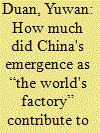

|
|
|
|
|
| Summary/Abstract |
Over time, China upgraded its capabilities to such an extent that it requires less imported materials, components, and services to maintain its central role in the global production network. Consequently, the domestic value added content of its exports has increased over time. Still, value added includes profits, which are partly earned by foreign capital owners, many of whom have set up operations in export processing zones. Such profits can be repatriated, and do not directly enhance the living standards in China. This paper will focus on the extent to which China's exporting activities have contributed to its Gross National Income (GNI), which is a better indicator of economy-wide living standards than GDP. Our results, based on input-output analysis, show that the increase in the share of Chinese GNI of a yuan of Chinese exports from 2002 to 2007 was modest, despite a marked growth of Chinese GDP contained in such a yuan of exports. From 2007 to 2017, however, the continued increase of domestic value added per yuan of exports did actually translate into considerably higher contributions of exports to GNI. Decomposition analyses show that changes in the commodity composition of China's export bundle and changes in the shares of national income in value added were the main cause of the different patterns before and after the financial crisis.
|
|
|
|
|
|
|
|
|
|
|
|
|
|
|
|
| 16 |
ID:
182797


|
|
|
|
|
| Summary/Abstract |
This study examines how human capital in the financial sector affects corporate debt maturity. To illustrate the mechanisms underlying the effects, we propose a theoretical framework that highlights the effects of human capital in the financial sector on mitigating the information asymmetry between financial intermediaries, households, and firms. Using the Chinese National Economic Census in 2008 and the Industrial Enterprises Database over 2011–2013, we find that the financial sector's human capital plays a significant and positive (negative) role in short-term (long-term) debt and this effect is more pronounced for firms with greater information asymmetry. Further analyses demonstrate that the baseline findings are consistent with the credit supply hypothesis. Our study indicates that human capital in the financial sector strengthens its renegotiation capacity for corporate borrowing, which is consistent with China's financial repression policy and leads to increased exposure of firms to credit and liquidity risks.
|
|
|
|
|
|
|
|
|
|
|
|
|
|
|
|
| 17 |
ID:
182793
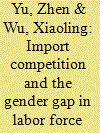

|
|
|
|
|
| Summary/Abstract |
Does import competition explain the gender gap in labor force participation? The distributional consequences of trade liberalization have fascinated decades of economists and policy makers. Using a difference-in-differences strategy, we find that import competition enlarges the gender gap in labor force participation in China during 1990 and 2005. The results are robust to various identification challenges, including contemporaneous confounders, treatment effect heterogeneity, and spatial correlations in standard errors. The magnitude of the gender-differential effects of import competition on labor force participation grows by age, and peaks for people aged 46–50. The household division of labor appears to explain the gender-differential effects. Import competition also leads to a relative contraction of female-intensive industries, and reduces the share of female employees in each industry.
|
|
|
|
|
|
|
|
|
|
|
|
|
|
|
|
| 18 |
ID:
182790


|
|
|
|
|
| Summary/Abstract |
The health risks from indoor and ambient air pollution create a considerable burden to global economic development and health, especially in economies within an aging society. Previous research has established the adverse effects of air pollution on health. However, most studies do not focus on the simultaneous effect of indoor and ambient air pollution nor its health risks to the older population. This study examines the impact of exposure to both indoor and ambient air pollution for the same individuals over time on mental health by using a nationally representative longitudinal survey for middle-aged and elderly individuals in China. We find that both indoor and ambient air pollution have an adverse effect on elderly mental health and significantly increases the likelihood of having depressive symptoms. We provide evidence that the effect of indoor and ambient air pollution is associated more with less educated and females.
|
|
|
|
|
|
|
|
|
|
|
|
|
|
|
|
| 19 |
ID:
182803


|
|
|
|
|
| Summary/Abstract |
This study contributes to the literature on inequality of opportunity (IOp) in China by covering a longer and more recent span of time, employing better measures of given characteristics, and analyzing IOp for household income per capita with comparisons to individual income. Furthermore, it analyzes how IOp differs between the rural- and urban-born, and how IOp changes across birth cohorts and with age. We use 2002, 2013 and 2018 data from the Chinese Household Income Study and focus on income inequality among working-age persons. We find that IOp in China declined, especially between 2013 and 2018. In 2002 the large contributors to IOp were region, hukou type at birth, and parents' characteristics. In 2018 the contributions of region, hukou type at birth and parents' occupation had decreased, but that of parents' education had increased. We find that IOp is larger among those born in rural than urban China. Furthermore, IOP's contribution to total inequality within each birth cohort is highest earlier in individuals' work lives and declines with age. IOp is higher for older than younger birth cohorts, reflecting that younger cohorts have benefited from increased opportunities associated with China's reforms and opening up.
|
|
|
|
|
|
|
|
|
|
|
|
|
|
|
|
| 20 |
ID:
182777


|
|
|
|
|
| Summary/Abstract |
Mergers and acquisitions (M&As hereafter) have been widely examined in the economic and business literature under many perspectives. However, the industry-level view, specifically the relation between industrial policies and M&A waves at the sectoral level, has remained rather unexplored. This article contributes to fill this gap by empirically investigating the relation between selective industrial policies and M&A waves at the industry level in China. Referring to the four Five Year Plans covering the period 1996–2015, we explore whether being identified as an emerging sector in these plans generates positive or negative changes in the number of M&As. We reiterate the analysis according to the different types of M&As (vertical, horizontal or conglomerate) and the different natures of the acquirer (SOEs or private). Our results suggest that policies can differentially affect M&A waves according to the type of M&A. Moreover, while private firms are more responsive to both horizontal and vertical integration in emerging sectors, SOEs are more prone to engage in vertical M&As. We discuss the possible rationales behind the different behaviors. We also draw general policy implications on strategic industrial policy and market restructuring.
|
|
|
|
|
|
|
|
|
|
|
|
|
|
|
|
|
|
|
|
|